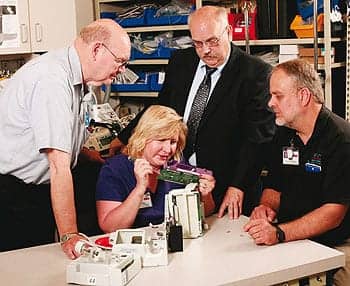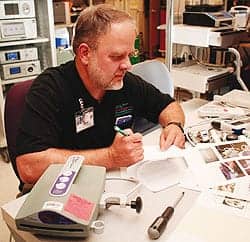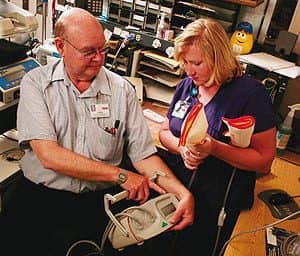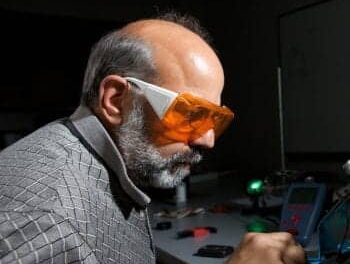
L-R: Duane Buss, BMET II; Deb Hoyt, BMET II; Russ Hill, interim account manager; and Kevin Rathjen, senior BMET.
As most industries and fields have recently been reminded, great recessions require great reductions. Sometimes those reductions can seem like a sacrifice, particularly when employees find their salaries, workloads, or general employment impacted. At Catholic Health Initiatives (CHI), a national nonprofit health organization headquartered in Englewood, Colo, economics have pushed the institution to make some inventive changes.
The decision with the biggest impact for the clinical engineering teams at Saint Francis Medical Center in Grand Island, Neb, and Good Samaritan Hospital in Kearney, Neb, and which has driven many of the teams’ other moves, has been the implementation of a new hierarchy: the two sister hospitals now share a manager. Work responsibilities have increased, workloads have been redistributed, and workflow is structured using prioritization.
Some of the changes, such as greater biomed involvement in capital acquisitions and PM scheduling, are keepers. Others, such as the shared manager, are likely to be abandoned once economics permit. In the interim, the teams manage as best they can, putting in a little extra time and thought to get everything done.
Shared Manager, Shared Resources
The decision to share a manager happened organically. At the end of 2009, the then-manager of the clinical engineering team at Saint Francis retired. “With the restraints that have been placed on everyone, we are on a hiring freeze,” says Deb Hoyt, BMET II, clinical engineering, with CHI at Saint Francis.
So CHI asked Russell Hill, the account manager of clinical engineering for the organization at Good Samaritan Hospital, to step in on an interim basis. “This is commonplace if you have shops relatively close so that you can share back and forth,” Hill says. Saint Francis and Good Samaritan have loaned equipment to each other to make up for shortages when necessary. Hill recalls an instance where he and a tech from Saint Francis drove their four-wheel-drive vehicles through the snow to meet in the middle and exchange a working bili light for one in need of service. Tips can be shared even more easily. “That can’t happen if you don’t have a common interest,” Hill says.
However, the two clinical engineering departments are not that close, physically (at 40 miles) or figuratively. “Ideally, we would have liked to share technicians, but the travel time cutting into actual preventive maintenance and repair time is seen as a disadvantage,” says Kevin Rathjen, senior BMET with CHI clinical engineering at Saint Francis.
The workflows seem even further apart. “The shops are only 40 miles away, but there still is a cultural difference between the two,” Hill says. “The ideology and workstyle of the two shops are different.” He attributes the dissimilarities to differences in management. “The shop in Grand Island, Saint Francis, had been under the previous manager for nearly 20 years and is using his concepts,” Hill says. “The shop here in Kearney has been using the concepts I have put in place over the past 3 or 4 years.”
Hill cites work order and reporting systems as having been varied among facilities. The differences, however, did not impact performance. Rathjen notes both shops get their jobs done and done well.
Despite this, CHI has begun to implement some standard practices and equipment throughout the organization. Its facilities are transitioning to one network database—the bugs are still being worked out—so the two shops will share the same software for total equipment asset management (TEAM). Hill has also selected a few additional areas of focus for standardization to bring the two shops more in line, “at least until the new manager takes over, and he might have a different way of thinking,” Hill says.
Shared Duties
Hill was never meant to remain a shared manager, but as the economy worsened, the interim basis was extended and the need to adapt became more acute. “At times, we get very frustrated with trying to figure out how to get everything done that is required of us,” Hoyt says.
Saint Francis has about 170 beds and roughly 7,000 pieces of equipment in its inventory. The clinical engineering department is comprised of three technicians and Hill, who is on-site 2 days per week. He spends 3 days at Good Samaritan, which has 287 beds, 9,000 pieces of equipment, and five techs, two of whom are field service specialists. In general, the clinical engineering teams at both Saint Francis and Good Samaritan prefer to keep service of equipment in-house. The field service specialists at the latter work on radiology equipment, and one also services cardiology. Saint Francis does not have a biomed technician who can focus on radiology machines.

Kevin Rathjen works on paperwork for a power cord recall.
“We don’t actually have enough staff here to send someone to school for a month to learn that equipment,” Hoyt says. But the department does manage more of the facilities equipment than Good Samaritan, such as patient aspirators, housekeeping vacuum cleaners, and surgical tables. “We try to manage all equipment if we can. Even if it’s a vendor that comes out and takes care of it, we still have to put the required paperwork into our system,” Hoyt says.
With Hill’s time divided, the biomeds find themselves handling more paperwork in general. “We are required to do more administrative-type duties, more paperwork, and more face-to-face time answering questions from directors of departments on the days the manager is not on-site,” Rathjen says.
The administrative duties encompass many facets, including capital acquisition, reporting, invoicing, scheduling, and even communication. “We cannot rely on stepping into the office and holding up something and asking, ‘How do you want us to proceed with this?’ It takes more time to explain over the phone or e-mail what we are doing,” Rathjen says.
Hospital directors have similar accessibility issues. “We cannot tell the site manager that, ‘The director of a department would like to discuss an issue or a contract with you at this time.’ ” Rathjen says. “Either we need to sit down with the director and reference to the best of our knowledge, or we can refer them to schedule a time when our site manager is on-site.” As a result, the team is pressed to manage all of its tasks. “One disadvantage is we are getting behind on our work,” says Duane Buss, BMET II on the Saint Francis/CHI clinical engineering team.
Shared Priorities
Hoyt concurs, saying, “Trying to learn to juggle the additional duties with our regular tasks has been a challenge.” To manage the workload, the team uses a risk-level prioritization methodology.
First come the PMs. “The primary goal of each shop is to maintain our preventive maintenance percentage within The Joint Commission and CHI requirements,” Hill says.
The PMs due each month are tackled by risk level, with level one being critical, life-saving devices and thus handled first. This group includes ventilators and defibrillators. Risk level five includes those items that can easily be seen malfunctioning but which do not harm the patient, such as an air mattress pump or battery-operated ottoscope.
“The rest of the equipment falls in between based on how it may affect the patient, how easily it is recognizable as failing, and the area in which it is used,” Rathjen says.
Of course, if a risk level one repair comes in and that particular device inventory is low, it will move to the head of the line. Normal repairs are completed once PMs are closed (but ideally within a week, according to Hoyt), and incoming equipment inspections and paperwork are fit in over an appropriate time period.
The PM schedule is more rigid but preplanned for maximum efficiency. CHI standards demand 100% PM completion by the end of the month for risk level one equipment and 95% for others. With a growing inventory and a shrinking staff, the team has used in-house historical data to modify PM schedules to more accurately reflect need and create greater efficiency.
“We go by manufacturer specs,” Rathjen says. “However, if we have something that has been a semiannual PM with no problems found in 2 to 3 years, we will change that schedule to annually and monitor if repairs become necessary. If we hear from staff or realize it is not going to work, then we will leave it as it is or readjust it back to the original schedule.”
Other low-risk items have been dropped from the PM list, but the staff in those departments were given training on checking certain functions, and the clinical engineering department continues to manage troubleshooting and repairs. If equipment breaks down frequently, clinical engineering will evaluate it and determine if it is feasible to repair it or else remove it from service. “We go into our history to identify which types of products give us the most problems,” Buss says.
The team also looks at the year and the facility as a whole. For instance, all 6-month PMs on the first floor are tackled in the first and sixth month of the year; PMs on the second floor are due in the second and seventh months, and so on through to floor seven. Risk-level items on that month’s floor are completed first to ensure that all pieces can be found. Forms are used to notify directors of the PM schedule as well as to ask for help finding missing devices. “Sometimes, it works best if you ask the director if they can get that device or find that equipment for you, so you don’t overlap into the next month,” Hill says.

Reports also deliver workloads to the biomeds. “Our software system helps us automatically generate 60 days in advance which PMs are due and which tech is assigned to it, so we always know in advance what we have for a PM workload,” Hoyt says.
The big-picture view allows the team to be somewhat creative in meeting PM goals. “For instance, if you have 400 PMs due this month and 100 due next month, there should be a way to a balance those out,” Hill says. “We still have the same amount of equipment, and we still need to do preventive maintenance on them, but why load yourself up and get frustrated one month, and the next month, you’re lean? You have to balance it out per month and also per technician to make sure no one is overloaded.”
Shared Knowledge
Of course, if one person is overloaded, the team will step up. “If somebody gets behind on repairs or PMs, we all take turns helping them out,” Buss says. Redundancy has been built into the system through education and subsequent in-services.
According to Rathjen, the team member who attended the school may be considered the specialist for that model or type of item, “but usually everyone has a good understanding and can do most of the troubleshooting with any piece of equipment.”
Continued education is required for all CHI techs. At the start of the fiscal year, each tech sits with the manager and reviews their goals for the upcoming year, sometimes going as far as 5 years out. A training schedule is then set up to reflect the biomed’s interests. The information is reviewed during the end-of-year evaluation.
“We like to have each tech go to one school a year,” Hill says. “Again, the way the economy has been, over this past year to year and a half, education sometimes hasn’t been where we would like it to be, so as things improve, we’ll be doing more schooling.” To ensure its investment, CHI asks biomeds to remain for a year following the training or pay for the class should they leave.
Hoyt was able to attend two schools this spring, one that was presented to four CHI facilities in a central location, reducing costs for the organization. Those educational opportunities that require airfare and hotel are typically more expensive. Because Saint Francis is a smaller facility, it purchases less equipment and has a little less leverage in negotiating training for more than one tech. However, the hospital recoups the money by having the team members share the information among one another. While attending the injector training, Hoyt provided an in-service on aspirators to other CHI clinical engineering team members. “Our train-the-trainer concept has worked well,” Hill says.
Shared Future
Another successful adaptation to the shared manager has been greater biomed involvement in capital acquisitions. Rathjen sees no disadvantages to the added responsibility outside of the time required to properly research. With clinical engineering approval needed, the department is better able to standardize equipment throughout the hospital, maximizing efficiency for not only biomeds but also clinicians (particularly floating nurses), accounting, and other hospital services.
Clinical engineering approval enables the facility to make pragmatic purchases. “When you have a director who is looking for a new piece of equipment, a new modality, a change of manufacturer, etc, they ask clinical engineering for assistance, and the tech that is most keen or knowledgeable with that department will help research the equipment they are looking for,” Hill says.

Duane Buss checks home health equipment returned from use in a patient’s home.
That biomed will discover whether a piece of equipment may have a reputation for unreliability, as well as other important details. Corporate can weigh in with pricing through its buying group.
Because both hospitals are growing and adding services, capital acquisition requests can occupy a significant amount of time: discussions take place with the department to determine need, products research is conducted, salesmen are consulted, forums are checked, and trials are completed (if possible). As more equipment comes in, the need for more staff will increase.
“We would like to see more people come in here and work with us as the amount of equipment we have has increased and our workload has increased. You can only expect a person to do so much,” Hoyt says.
The teams anticipate the addition of a manager devoted to Saint Francis. “We’ve kind of proven that one account manager is too much for the two shops, especially when we are so different and 45 miles apart from each other,” Hoyt says. “They had to try it to see if it would work. Sometimes it does, and sometimes it doesn’t, but, in this case, I don’t think it is working.”
Hill does envision the addition of a manager, and if he or she can also work on equipment, that would be a plus. “But I can also envision them adding a fourth technician to the mix so we can work on other modalities of equipment that we have, like radiology. If we can eliminate some of our expensive contracts and take them in-house, it’s a plus for the hospital because we can save some of those service dollars and bring them back into the facility,” Hill says.
When the economy will turn around for certain is still unclear, but the biomedical teams at both Saint Francis and Good Samaritan are happy to do their share—maybe even more than their fair share—to deliver high-quality patient care.
Renee Diiulio is a contributing writer for 24×7. For more information, contact .




